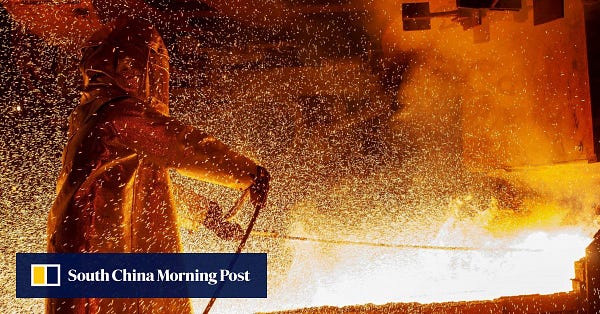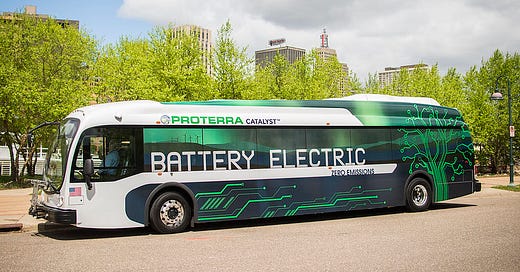I’m Ian Morse, and this is Green Rocks, a newsletter that doesn’t want dirty mining to ruin clean energy.
In the holiday spirit, give a gift subscription!
Ok, let’s talk about batteries. I promise I won’t use the word “regulation” at all. Starting now.
The last time the EU made rules on batteries, it was 2006 and not many people were expecting that the gadget would become a climate tool.
Now that the battery industry — phones but also electric cars and energy storage for wind and solar power — is set to skyrocket, people are beginning to realize the extractive toll that it may take from the earth. Batteries are complex concoctions of metals from around the world: copper, aluminum, lithium, cobalt, nickel, and the list is getting longer as companies want more diverse products. The dominant type, the lithium-ion battery, doesn’t last forever. Experts predict dead batteries will jump seven times their current level by 2030.
That presents two problems for environmental goals: potentially dirty manufacturing and waste. The EU is the first to try to rein in these issues. Last week, it proposed some rules. (I hinted at it last edition.)
“This proposal is really the first of its kind, and it can really set the standards globally.” Cecilia Mattea of Transport and Environment told me on Monday. “I think it’s the first time supply chain due diligence is recognized as a goal specifically for technology.”
It’s a skeleton of a first draft, with good ideas and weaker ideas. Here are three main points:
Each battery sold in the EU must meet carbon footprint limits by 2027.
By 2030, no EV or stationary storage batteries are thrown out. All are recycled, but not all of the metals within are expected to be reused.
By 2030, 12% of cobalt in batteries must be from recycled sources. For lithium and nickel, the figure is 4%. The minimums increase slightly in 2035.
Over the next month and a half, Mattea will be working to push the proposal even further than it has gone. Lithium recycled content rates, for example, are “quite low.” By 2025, the EU proposes, only 35% of lithium would be used again. Additionally, all manufacturing plants should have direct access to renewable energy, she says.
“Overall we’re pretty happy,” Mattea says. “But now the devil is in the detail, and the hard work begins in 2021.”
Mining is the elephant in the room. The proposal already recommends calculating a carbon footprint throughout a value chain, and that means knowing where metals came from. But the proposal stops at calculating carbon intensity at the mine level.
“But how about other types of pollution or other types of environmental damage? How do you take those into account?” For Mattea, those kinds of questions are not answered. Environmental damage can also be social damage, such as land conflicts and protests over wages.
So far, the proposal recommends creating “mandatory supply chain due diligence,” such as guidelines provided by the OECD. Those rules have received hefty criticism for failing on social and environmental protections. As we read a few weeks ago, Europeans are worried that the growth in clean energy tech will create more destructive mines.
A focus on recycling implies that the EU is trying to limit the amount of earth dug up. A robust recycling industry also makes the EU more independent, and keeps business (and metals) inside the bloc. The proposal has not yet outlined how recycling capacity will meet a 2030 goal to provide enough recycled metal.
It may seem like the EU is ahead of the curve, but as Hans Eric Melin of Circular Energy Storage told PV Magazine, “Europe’s battery recycling quotas are blunt and a decade too late.” The EU is just 17% of the battery market, with few factories. Melin think that will make regulation tricky. Oops, I said it.
More from PV Magazine and the EU Commission and the proposal itself.
Eye on Industry
BMW is integrating sustainability requirements into its contracts with producers of minerals and metals, particularly cobalt and lithium.
In 2030, we could be recycling three times as many batteries as we do today, according to consultancy IHS Markit. At the same time, end-of-life batteries will increase seven times its size today.
Mining is banned in Chubut province, Argentina, but a few mining companies are close to receiving legislative permission to begin operations.
Jamaica’s first deep-sea mining company approved for exploration is owned by two Europeans from the oil and gas industry.
Ecuador’s government is looking to upgrade the country’s copper industry to the level of the world’s biggest mining countries, but Indigenous groups have had some success in stopping them. Two of five multi-billion-dollar planned mines have been completely halted.
Rare earths miners are going to try to establish environmental standards next year, after years of criticism from buyers.
The company behind what has been dubbed the “worst environmental disaster in Brazil” is restarting after its tailings dam burst five years ago.
Two protests against nickel miners:
In Indonesia, protesters at a nickel smelter demanded higher wages and set vehicles alight.
Locals in New Caledonia, a French territory in the Pacific, occupied and set fire to a major nickel and cobalt mine that is transferring owners from Brazil’s Vale to European-based companies. Locals are angry the mine’s new owners don’t include more locals. About half the island’s population are colonial descendants.


Reads
≠ endorsement
Brazilians impacted by mining assert: ‘Genocide legalized by the state’ (Mongabay)
Bauxite mining threatens India’s lone wolf sanctuary and an interstate river (Mongabay India)
100% clean power? Don't wait for new technology, study says (E&E News)
And Indonesia seems to be getting closer to Tesla money:


Thanks for reading! I’m Ian Morse, and this is Green Rocks, a newsletter that doesn’t want dirty mining to ruin clean energy.
These topics are relevant to anyone who consumes energy. If you know someone like that, tell them to sign up!







